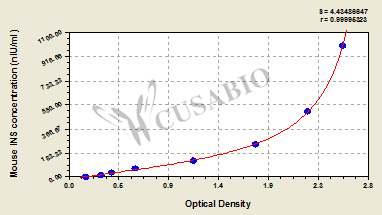| Code | CSB-E05071m |
| Size | 96T,5×96T,10×96T |
| Price | Request a Quote or Start an on-line Chat |
| Trial Size |
24T ELISA Kit Trial Size (Only USD$150/ kit) * The sample kit cost can be deducted from your subsequent orders of 96T full size kits of the same analyte at 1/5 per kit, until depleted in 6 months. Apply now |
| Intra-assay Precision (Precision within an assay): CV%<8% | ||||||
| Three samples of known concentration were tested twenty times on one plate to assess. | ||||||
| Inter-assay Precision (Precision between assays): CV%<10% | ||||||
| Three samples of known concentration were tested in twenty assays to assess. | ||||||
| To assess the linearity of the assay, samples were spiked with high concentrations of mouse INS in various matrices and diluted with the Sample Diluent to produce samples with values within the dynamic range of the assay. | ||||||
| Sample | Serum(n=4) | |||||
| 1:100 | Average % | 90 | ||||
| Range % | 84-95 | |||||
| 1:200 | Average % | 93 | ||||
| Range % | 90-96 | |||||
| 1:400 | Average % | 95 | ||||
| Range % | 90-100 | |||||
| 1:800 | Average % | 94 | ||||
| Range % | 87-99 | |||||
| The recovery of mouse INS spiked to levels throughout the range of the assay in various matrices was evaluated. Samples were diluted prior to assay as directed in the Sample Preparation section. | ||||||
| Sample Type | Average % Recovery | Range | ||||
| Serum (n=5) | 98 | 92-102 | ||||
| EDTA plasma (n=4) | 89 | 82-96 | ||||
| These standard curves are provided for demonstration only. A standard curve should be generated for each set of samples assayed. | |||||||||||||||||||||||||||||||||||||||||||||||||||||||||||||||

|
|||||||||||||||||||||||||||||||||||||||||||||||||||||||||||||||
This Mouse INS ELISA Kit was designed for the quantitative measurement of Mouse INS protein in serum, plasma, cell culture supernates, tissue homogenates, cell lysates. It is a Sandwich ELISA kit, its detection range is 15.6 nIU/mL-1000 nIU/mL and the sensitivity is 3.9 nIU/mL .
Sample type: Serum
Sample species: Mouse
Review: Serum insulin levels at the end of the 5-week administration. Data are presented as mean ± SEM. **p < 0.01 and *p < 0.05 versus model group, respectively. Normal, normal mice group; Model, T2D mice group; Met, T2D mice group administrated with metformin at 200 mg/kg/day; GXG-H, T2D mice group administrated with 200 mg/kg/day; GXG-L, T2D mice group administrated with 50 mg/kg/day.
By Anonymous
Sample type: Serum
Sample species: Mouse
Review: Effects of BDE-209 on serum insulin concentration in mice. Insulin level in serum treated with various dosages of BDE-209. *p < 0.05, compared with control group.
By Anonymous
Sample type: Serum
Sample species: Mouse
Review: Polytherapy with reserpine and GLP-1 increases serum insulin levels in STZ-induced diabetes. Note that both, monotherapy with reserpine and polytherapy with GLP-1/reserpine elevated serum levels of insulin compared to diabetic and healthy control mice.
By Anonymous
Sample type: Serum
Sample species: Mouse
Sample dilution: No dilution
Review: Using Mouse Insulin,INS ELISA Kit to detect the concentration of insulin in mouse serum, the OD value is 0.7813, which is within the range of the standard curve, and the absolute value is in line with the normal concentration. The standard curve is shown in the attached figure.
By Anonymous
Sample type: Serum
Sample species: Mouse
Sample dilution: No dilution
Review: I used CSB-E05071m to measure fasting serum insulin in spontaneous type 2 diabetes mellitus db/db and high-fat-fed C57 mice, and the concentration of the results may not be particularly high in 1:200 dilution, but there are still differences in the comparisons; that is, the method of dilution needs to be diluted twice, which is troublesome in case of a large amount of samples -; my classmates used alpco to add 5u directly on the line, but the steps of Huamei are relatively simple. The alpco can be used to add 5u directly, but the steps of CUSABIO are relatively simple, and I have already asked my siblings to use CUSABIO!
By Anonymous
Sample type: Serum
Sample species: Mouse
Sample dilution: No dilution
Review: I used CSB-E05071m to detect the serum insulin concentration of normal mice, and the OD values were: Jingjing: 0.2241, 0.2555, 0.3090, which was convenient and quick to use.
By Anonymous